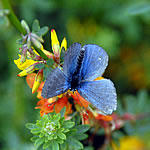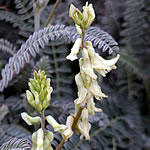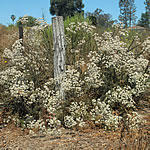Did you know that Palos Verdes has a native indigenous Palos Verdes Blue Butterfly that

is on the endangered species list? Known as the worlds rarest butterfly, the Palos Verdes Blue Butterfly has a small silvery blue colored wings with a black trim. Discovered in the southern hills of Palos Verdes there are groups that are trying to restore the habitat and farming the butterfly to later release in the natural habitat. Have you seen one?
You can help this butterfly by planting local coastal sage scrub.
By introducing coastal sage scrub into your landscape design a resident can improve habitat for the PV Blue Butterfly, but a number of other wildlife species as well!
The PV Blue Butterfly will only use two native plants for its egg laying site or host plants. These are Deerweed (Acmispon glaber) and Rattlepod (Astragalus trichopodus).
Other coastal sage scrub species that will help other native wildlife species are: Common CSS Species:
California Sage Brush (Artemisia California)
California Buckwheat (Eriogonum fasciculatum)
California Bush Sunflower (Encelia californica)
Lemonadeberry (Rhus integrifolia)
California Poppy (Eschscholzia californica)

Coyote Brush (Baccharis pilularis)
Purple Needle Grass (Stipa pulchra)
Purple Sage (Salvia leucophylla)
Black Sage (Salvia mellifera)
White Sage (Salvia apiana)
Coastal Prickly Pear (Opuntia littoralis)

Palos Verdes Blue Butterfly
Information provided by Palos Verdes Peninsula Land Conservancy (pvplc.org) [email protected], 310.541.7613
https://pvplc.org/_lands/index.asp
Info: https://pvplc.org/_education/native_plants.asp
After all the rain from the 2018 winter season, Palos Verdes had a major Superbloom. Plants, animals, and insects are flourishing, but there is a bird that is getting driven out of their home. I called it the Palos Verdes Blue Bird, but the correct name of this bird is the Western Pacific Blue Bird. In order to help promote the habitat for this bird, Jason has created PV Bluebird Nest Box

When it comes to rare plants and animals, disappearing habitats and pressing environmental concerns,
the Palos Verdes Peninsula, from tidepools to hilltop, is one of the most remarkable and vulnerable places in California. For most of its million-year existence, what is now the Palos Verdes Peninsula was once one of the Channel Islands. During that period, a unique flora and fauna evolved. Some of that uniqueness survives, despite extensive landform and habitat alterations, and despite the mainland connection, better
know as the Los Angeles Basin.

The lowlands adjacent to the Palos Verdes Peninsula are important to wildlife, too. As wetlands continue to fall victim to “progress,” those that remain in the South Bay become ever more valuable. In addition, our coastal strand still supports some of California’s rarest birds and other creatures.
Copied from Palos Verdes / South Bay Auborn Society
https://www.pvsb-audubon.org/aboutus.html
Jason is building Bird Box’s as a home project that kids can put together, or assembled. Please call or write to Jason to get your Bird Box and help local wildlife.

SUPERBLOOM FIRE DANGER
This Spring flowers were everywhere, however, a majority of the color was yellow as the mustard plant took over. Its the first to grow in the season and it grows fast, so it blocks the sun from other indeginious plants. Then, when it dies, it becomes a major fire hazard.
https://www.latimes.com/local/lanow/la-me-ln-mustard-fire-santa-monica-mountains-20190425-story.html


Leave a Reply